Dolphins are among the most intelligent and charismatic marine mammals, known for their playful behavior and acrobatic displays. With approximately 40 species worldwide, there are many fascinating types of dolphins, each with unique features and adaptations. Belonging to the families Delphinidae (oceanic dolphins), Platanistidae (Indian river dolphins), Iniidae (New World river dolphins), and Pontoporiidae (brackish dolphins), these creatures inhabit oceans and rivers across the globe.
In this article, we explore 28 remarkable types of dolphins, complete with images and identification tips to help you recognize these captivating marine animals.
Different Types of Dolphins
Bottlenose Dolphin
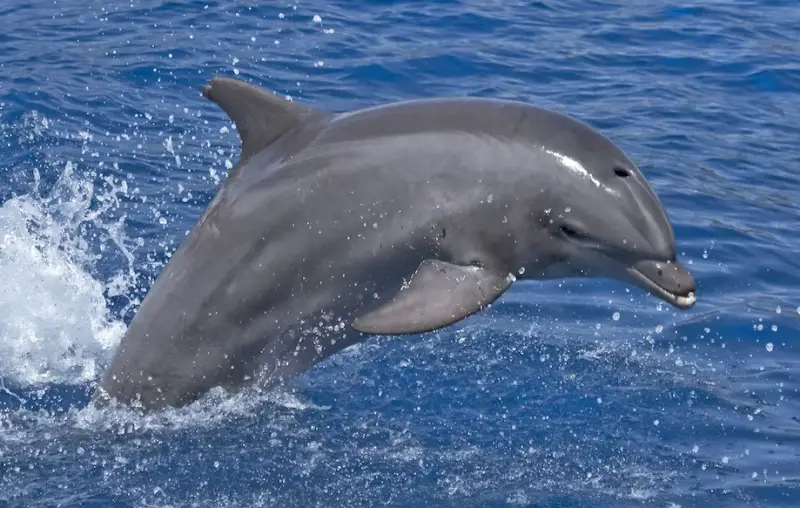
The Bottlenose Dolphin is widely recognized for its intelligence and social behavior. Typically found in coastal and open ocean waters, they can reach lengths of 6 to 13 feet and weigh between 330 and 1,430 pounds. These dolphins are skilled hunters, feeding mainly on fish and squid. They are known for their strong communication abilities and complex problem-solving skills, which make them one of the most studied marine species.
Although common in marine parks, Bottlenose Dolphins are listed as “Least Concern” by conservationists, indicating a stable population. Their long lifespan of 40 to 60 years highlights their resilience, and their social nature allows them to thrive in both the wild and in captivity.
Common Dolphin
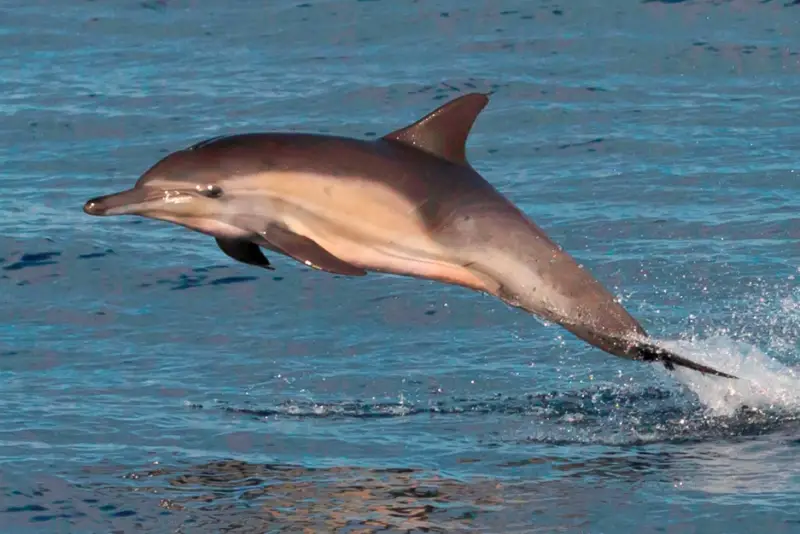
The Common Dolphin, also called the Short-Beaked Common Dolphin, is notable for its distinctive yellow-grey-black side pattern. Preferring warm, coastal, and open seas, they grow to a length of 6.2 to 8.2 feet and weigh between 176 and 518 pounds. These dolphins primarily feed on squid and small fish such as sardines and anchovies, and they can live up to 40 years.
Their agility and speed make them exceptional swimmers, often seen engaging in acrobatic displays. Despite threats from human activities like fishing and pollution, Common Dolphins maintain a stable population and are considered a species of “Least Concern” in terms of conservation.
Spinner Dolphin
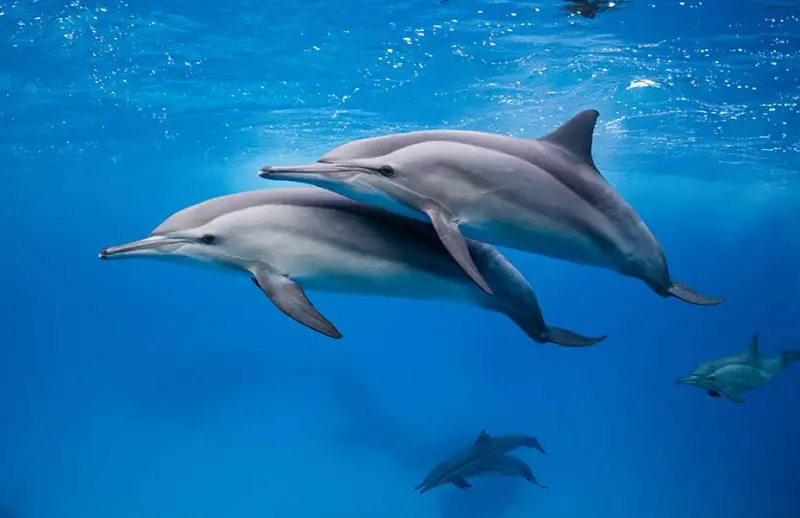
Spinner Dolphins are known for their small size and acrobatic spinning behavior. Measuring between 4 to 7 feet long and weighing between 130 and 170 pounds, these dolphins inhabit tropical offshore waters worldwide. Their diet includes small fish, squid, and occasionally crustaceans, and they typically live 20 to 30 years.
The name “Spinner Dolphin” comes from their unique behavior of spinning while leaping out of the water, which is believed to be a form of communication or parasite removal. These dolphins gather in large groups, and although they face risks from fishing nets, their population remains stable with a conservation status of “Least Concern.”
Risso’s Dolphin
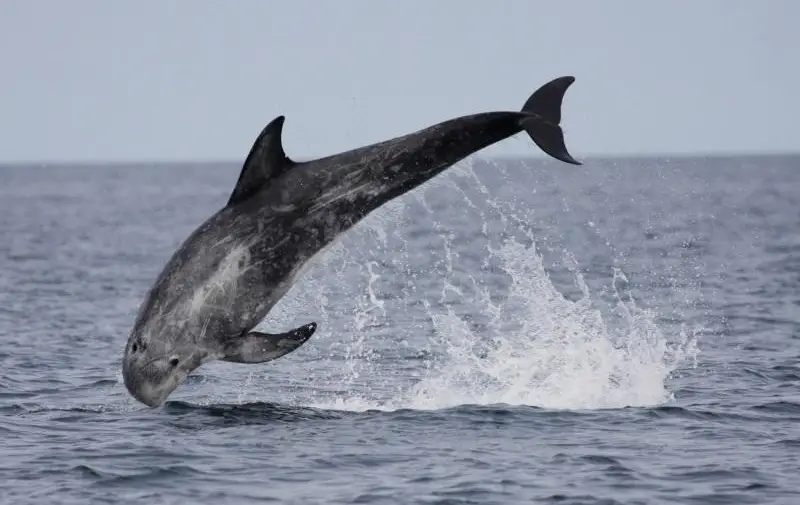
Risso’s Dolphin, a large and robust species, is recognized by its bulbous head and narrow tailstock. These dolphins, which inhabit deep, temperate, and tropical waters, typically range from 8.5 to 13 feet in length and weigh between 660 and 1,100 pounds. They mainly feed on squid, fish, and octopus, and they can live for over 35 years.
One of the most interesting features of Risso’s Dolphins is their heavily scarred skin, which becomes more prominent as they age. These scars result from interactions with other dolphins or from their prey. Despite these marks, Risso’s Dolphins are not currently endangered, and their conservation status is “Least Concern.”
Orca (Killer Whale)
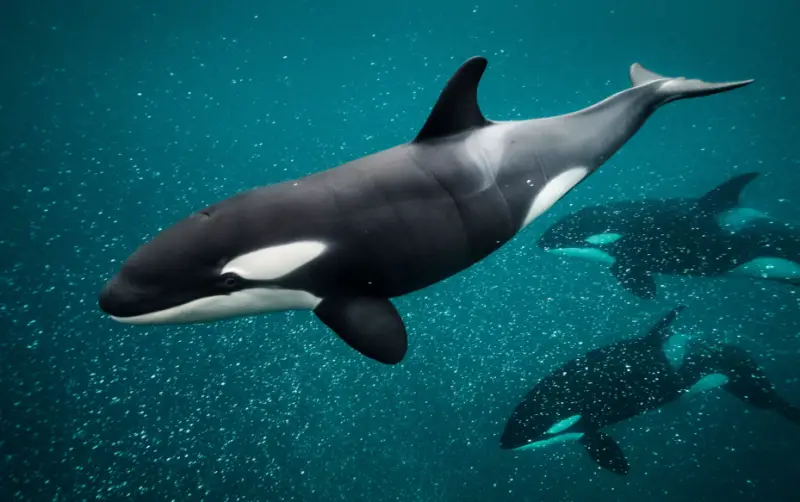
The Orca, also known as the Killer Whale, is the largest member of the dolphin family, growing up to 32 feet and weighing as much as 22,000 pounds. Found in oceans worldwide, Orcas primarily hunt fish, mammals, and birds. Females can live up to 90 years, while males have an average lifespan of 60 years.
Known for their distinctive black-and-white coloring and complex vocalizations, Orcas have unique dialects within their pods. This ability to communicate sets them apart from other dolphin species. Although their populations are generally stable, their conservation status is listed as “Data Deficient,” requiring further research on their global status.
Amazon River Dolphin
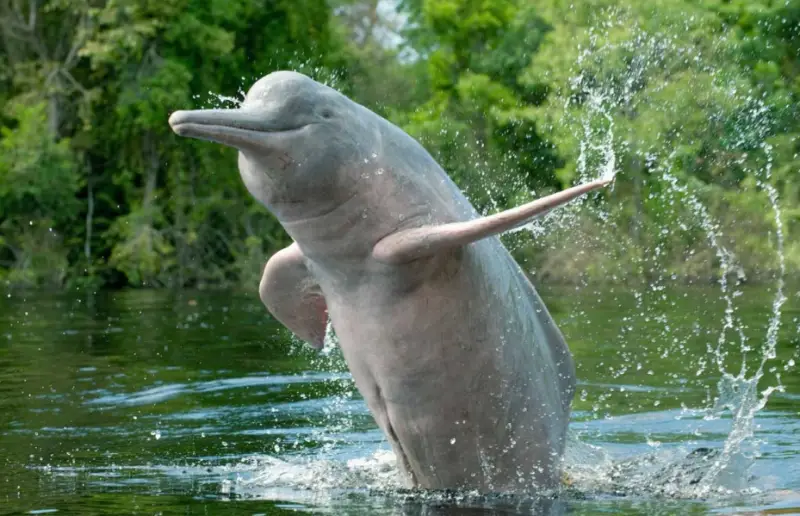
The Amazon River Dolphin, also known as the Pink River Dolphin, is a freshwater species that inhabits the rivers, lakes, and flooded forests of the Amazon Basin. Known for their distinct pink coloration, these dolphins can grow between 5 and 8.2 feet and weigh up to 408 pounds. Their diet consists of fish, turtles, crabs, shrimp, and other crustaceans, allowing them to thrive in the diverse ecosystem of the Amazon.
One of the Amazon River Dolphin’s unique features is its highly flexible neck, which helps it navigate through the complex, murky waters of the flooded forests. These dolphins also exhibit sexual dimorphism, with males typically being larger and more brightly pink than females. Unfortunately, their population is endangered due to habitat destruction and pollution.
Irrawaddy Dolphin

The Irrawaddy Dolphin is a rare and distinctive species found in the coastal areas of Southeast Asia and the Bay of Bengal. Ranging in size from 6.5 to 9.2 feet and weighing up to 440 pounds, they are known for their unique ability to adapt to varying salinity levels, a rare trait in the dolphin world. Their diet includes fish, cephalopods, and crustaceans, and they typically live up to 30 years.
These dolphins are socially shy, often seen in small groups and avoiding human interaction. However, in some regions, such as the Irrawaddy River, they have been observed assisting local fishermen by herding fish into nets, a remarkable example of interspecies cooperation. Despite their unique behaviors, they face significant threats from habitat loss, making them endangered.
Hector’s Dolphin
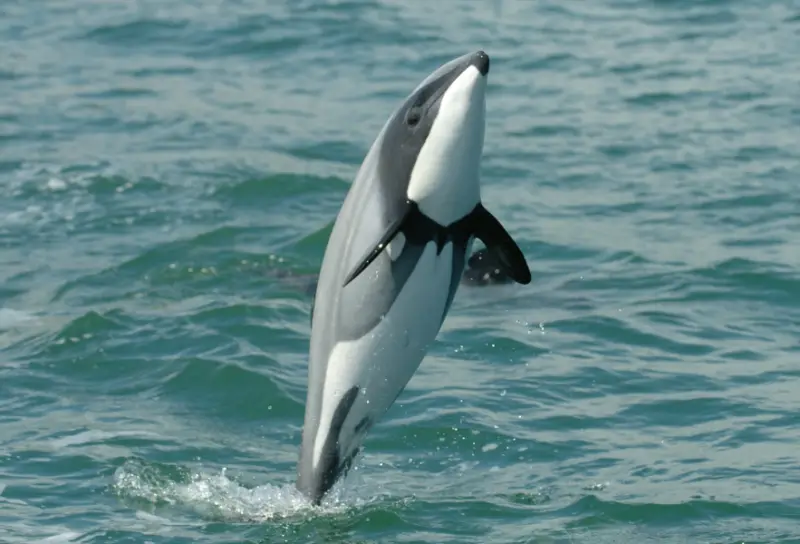
Hector’s Dolphin is a small, endemic species found only in the coastal waters of New Zealand. These dolphins have unique black facial markings and short, stocky bodies, with a dorsal fin resembling Mickey Mouse ears. They measure between 4 and 5.25 feet and weigh between 88 and 132 pounds, making them one of the smallest dolphin species.
Known for their playful nature, Hector’s dolphins primarily feed on fish, cephalopods, and crustaceans. Due to their limited habitat range, their conservation is vital for preserving New Zealand’s marine ecosystem. Unfortunately, Hector’s Dolphins are listed as endangered, facing threats from human activity, including fishing and habitat degradation.
Atlantic Spotted Dolphin
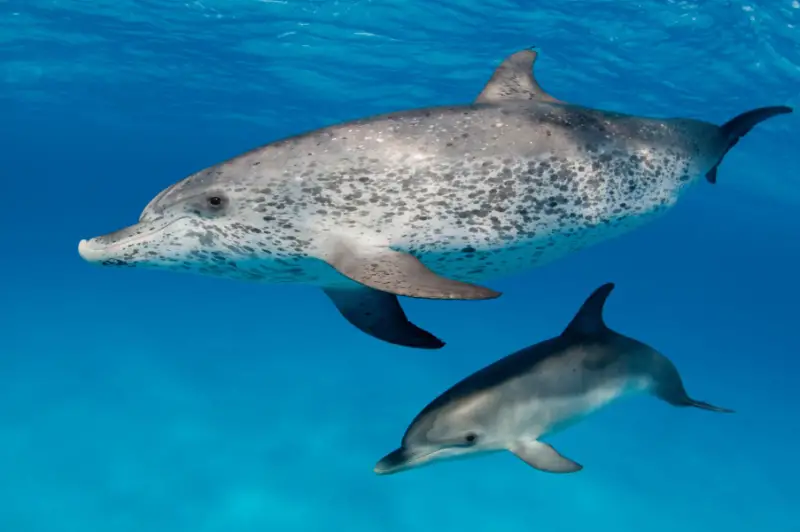
The Atlantic Spotted Dolphin is a medium-sized dolphin species that can be found in the warm, temperate, and tropical waters of the Atlantic Ocean. They range from 5 to 7.5 feet in length and weigh between 220 and 315 pounds. These dolphins are known for their distinctive spotted patterns, which develop as they age, starting with a dark gray color in younger dolphins.
Atlantic Spotted Dolphins primarily feed on bottom-dwelling invertebrates, squid, and fish. They are highly social and playful animals, often seen in large pods. Despite facing potential threats from fishing nets and environmental changes, their population is relatively stable, and their conservation status is listed as “Least Concern.”
Pantropical Spotted Dolphin
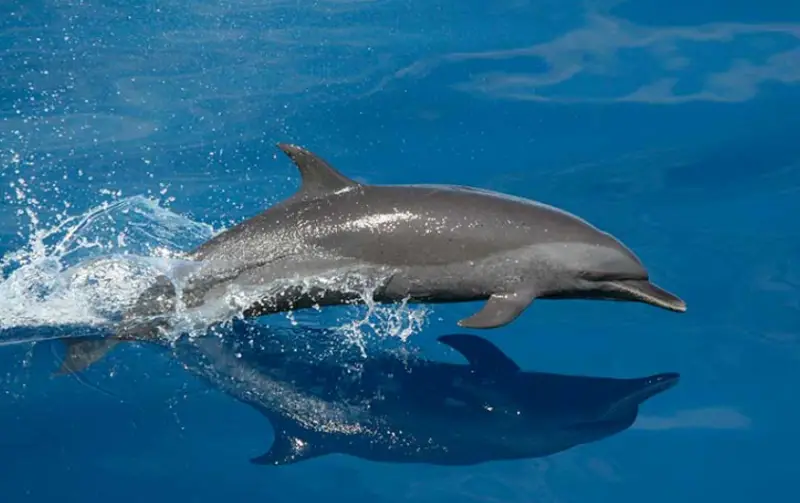
The Pantropical Spotted Dolphin is widely distributed across the world’s tropical and temperate oceans, typically growing between 6 and 7 feet in length and weighing up to 250 pounds. These dolphins are recognized by their sleek bodies and characteristic spots, which become more pronounced with age. They mainly feed on small fish, squids, and crustaceans.
One interesting fact about Pantropical Spotted Dolphins is their close association with yellowfin tuna, particularly in the eastern tropical Pacific. Unfortunately, this leads to significant bycatch in tuna fisheries, which has historically affected their population. However, their conservation status is currently listed as “Least Concern,” indicating that their population has stabilized.
Striped Dolphin
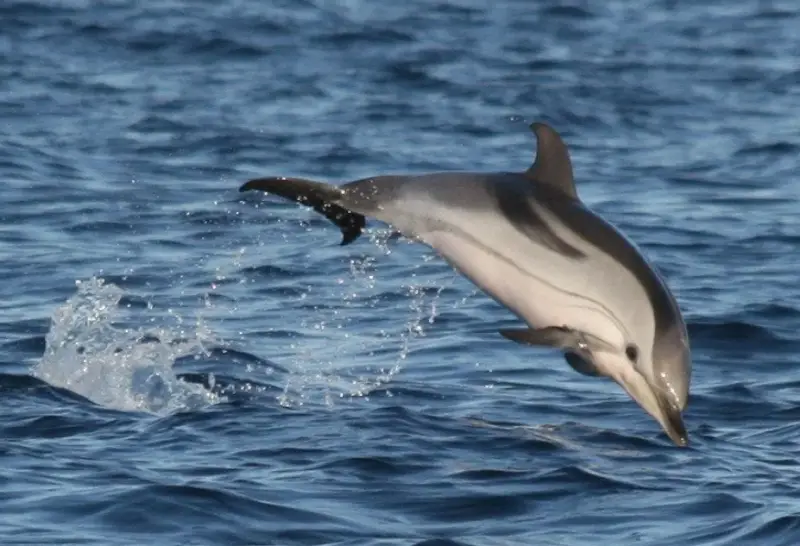
The Striped Dolphin is a striking species known for its distinctive blue and white stripes running from its eyes to its flippers. These dolphins are found in temperate and tropical waters across all the world’s oceans. They are medium-sized, growing between 7.9 and 8.5 feet long and weighing between 330 and 352 pounds.
In addition to their unique markings, Striped Dolphins are famous for their high-speed swimming and acrobatic displays, often seen leaping and spinning through the air. They primarily feed on fish and squid and can live up to 60 years. Despite their speed and agility, they are listed as “Least Concern” for conservation, with stable population levels.
Rough-Toothed Dolphin

The Rough-Toothed Dolphin is a unique species with a conical head, slender nose, and distinctive rough teeth. These dolphins are typically found in tropical to warm-temperate oceanic waters, especially in deeper regions. They measure between 7 and 9.3 feet in length and weigh between 198 and 341 pounds.
Rough-Toothed Dolphins have a varied diet, including large fish, squids, octopuses, and houndfish. Their rough teeth allow them to grip slippery prey, a feature not found in many other dolphins. Their specialized feeding technique makes them stand out, and they are considered “Least Concern” for conservation due to their wide distribution and stable population.
Pacific White-Sided Dolphin
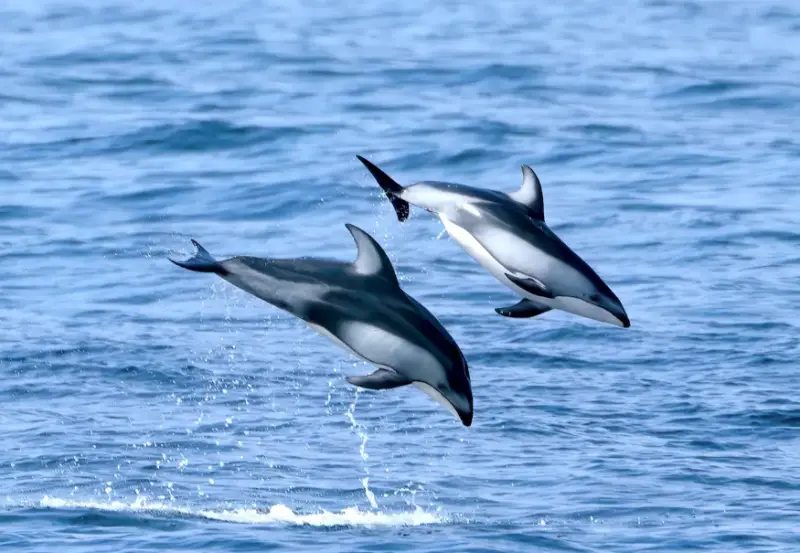
The Pacific White-Sided Dolphin is a beautiful species known for its distinct three-color pattern. They are found in the temperate waters of the northern Pacific Ocean, with males reaching up to 8 feet and females slightly smaller at 7.5 feet. They weigh between 300 and 400 pounds.
These dolphins are highly social and often form large groups, swimming together and displaying acrobatic behavior, such as leaping near boats. Their diet consists of squid and small schooling fish. Pacific White-Sided Dolphins can live up to 40 years, and their strong social bonds and caring behaviors make them unique. They are currently classified as “Least Concern.”
Commerson’s Dolphin
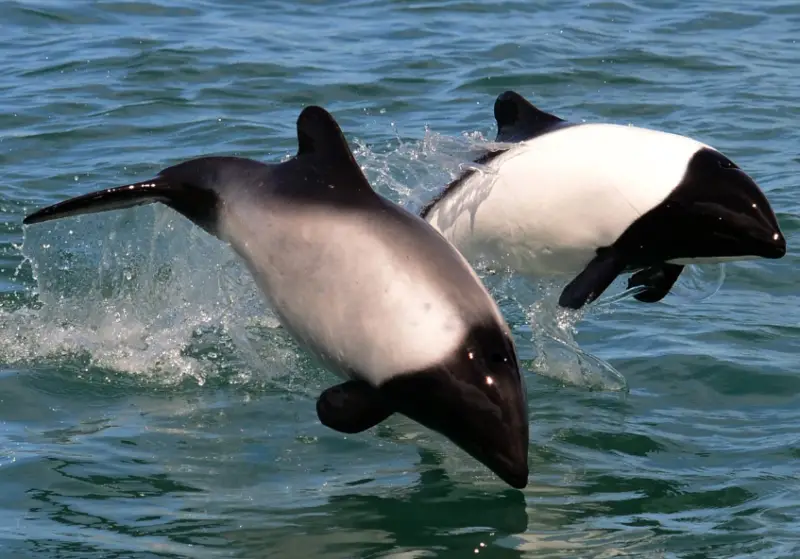
Commerson’s Dolphin, known for its striking black and white color pattern, is often called the “skunk dolphin” or “panda dolphin.” These small dolphins are found in the coastal waters of the southwest Atlantic, particularly around Patagonia and the Falkland Islands. They measure between 3.9 and 5.6 feet and weigh between 77 and 132 pounds.
Their diet consists mainly of fish, squid, and marine invertebrates. They are highly social, often seen in small pods of 2 to 3 dolphins, and have complex communication systems. Their bold black-and-white pattern is believed to help them signal each other or blend into their surroundings. Commerson’s Dolphins are considered “Least Concern” for conservation.
Dusky Dolphin
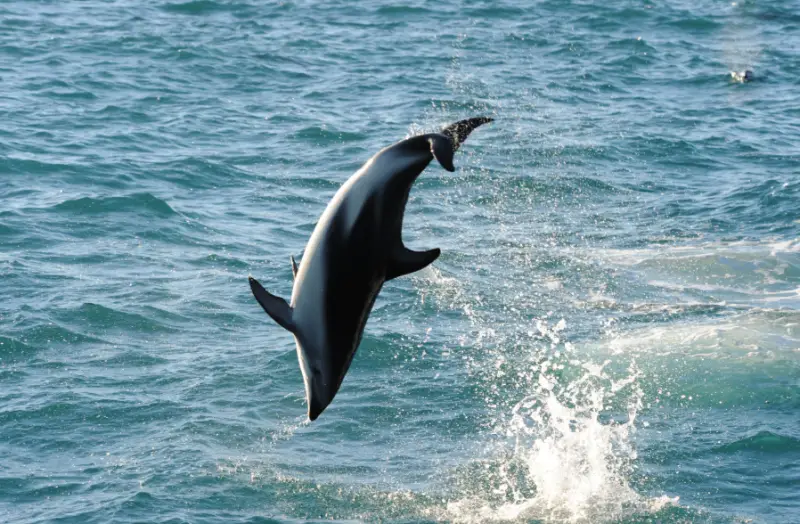
The Dusky Dolphin is a distinctive species known for its bluish-black back and tail, contrasting with its white underside. They have a short snout, rounded dorsal fin, and are mainly found in the coastal waters of the Southern Hemisphere. Females grow to about 5.5 to 5.8 feet, and males are slightly smaller, measuring 5.4 to 5.7 feet. They weigh between 152 and 172 pounds for females and 154 to 187 pounds for males.
These dolphins primarily feed on small fish and squid. They are known for their playful nature and acrobatic skills, often seen swimming in energetic groups. Dusky Dolphins have a relatively short lifespan of 18 to 25 years, and their population is stable, classifying them as “Least Concern.”
Australian Snubfin Dolphin
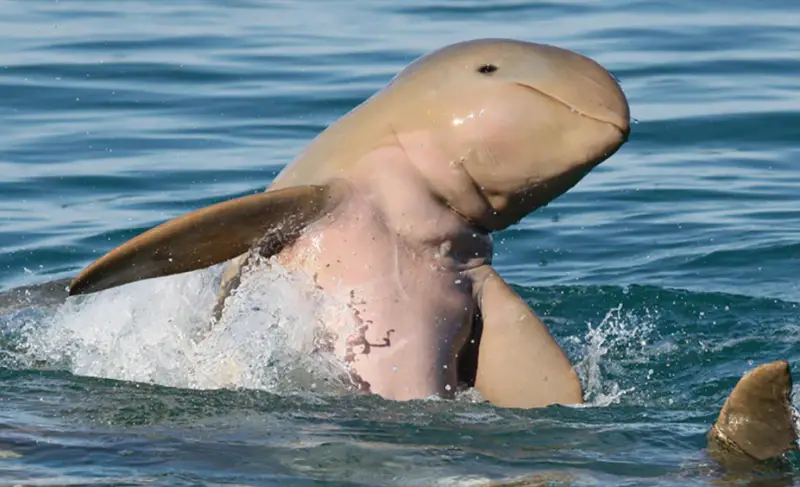
The Australian Snubfin Dolphin, distinguished by its rounded head and absence of a beak, is a remarkable species found in the shallow coastal waters of northern Australia and Papua New Guinea. These dolphins measure between 6.6 and 7.9 feet in length and weigh between 251 and 293 pounds. They primarily feed on smaller fish, cephalopods, and shrimp and can live up to 30 years.
One of the most unique features of this species is its distinct neck crease, a characteristic uncommon in other dolphins. Unfortunately, due to threats like habitat loss and entanglement in fishing gear, the Australian Snubfin Dolphin is listed as “Vulnerable.”
White-Beaked Dolphin
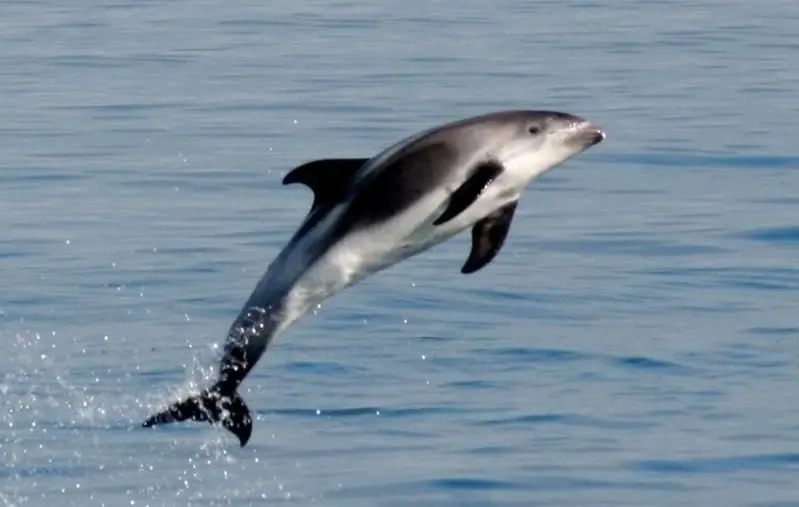
The White-Beaked Dolphin is a beautiful species found in the cold waters of the North Atlantic, including a unique population in the English Channel. They have a stout beak and a large dorsal fin, which makes up about 15% of their body length. Their body color is primarily dark gray or black with white patches, making them easily recognizable.
They grow to a size of 7.6 to 10.2 feet and weigh between 397 and 780 pounds. These dolphins feed on fish, crustaceans, and cephalopods and can live up to 40 years. Known for their playful nature and acrobatic abilities, the White-Beaked Dolphin is classified as “Least Concern” for conservation.
Atlantic Humpback Dolphin
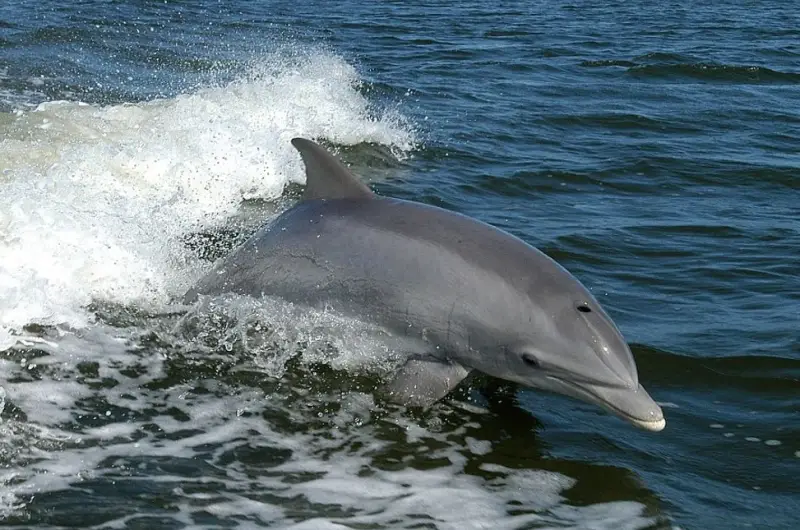
The Atlantic Humpback Dolphin is known for its distinctive hump in front of the dorsal fin. These dolphins, which inhabit the coastal waters of West Africa, measure between 5.9 and 8.5 feet and weigh between 220 and 330 pounds. Their diet primarily consists of mullet and other fish species.
A unique aspect of the Atlantic Humpback Dolphin is its collaboration with Mauritanian Imraguen fishermen. The dolphins help herd fish into the fishermen’s nets, a fascinating example of human-wildlife cooperation. Unfortunately, due to habitat degradation and fishing threats, the Atlantic Humpback Dolphin is classified as “Critically Endangered.”
Indo-Pacific Humpback Dolphin
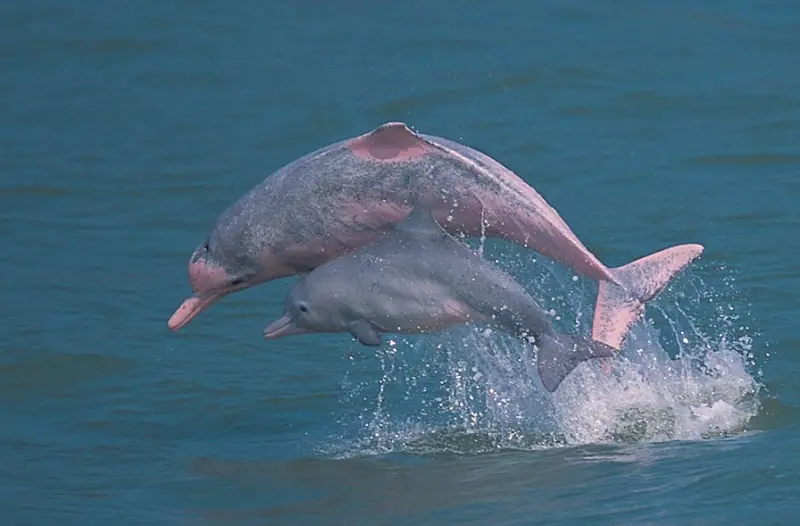
The Indo-Pacific Humpback Dolphin, also known as the Chinese White Dolphin, is found in warm, shallow waters above 59°F (15°C). They can grow up to 11.5 feet in length and weigh between 440 and 660 pounds. Their diet consists mainly of mullet and other fish species.
These dolphins are famous for their color-changing process, where their grayish hue gradually turns into a striking pinkish-white as they age. With a lifespan of around 40 years, these dolphins are known for their friendly nature and are often seen approaching humans. However, they are at risk due to habitat destruction and pollution, making them “Vulnerable” in conservation status.
Peale’s Dolphin
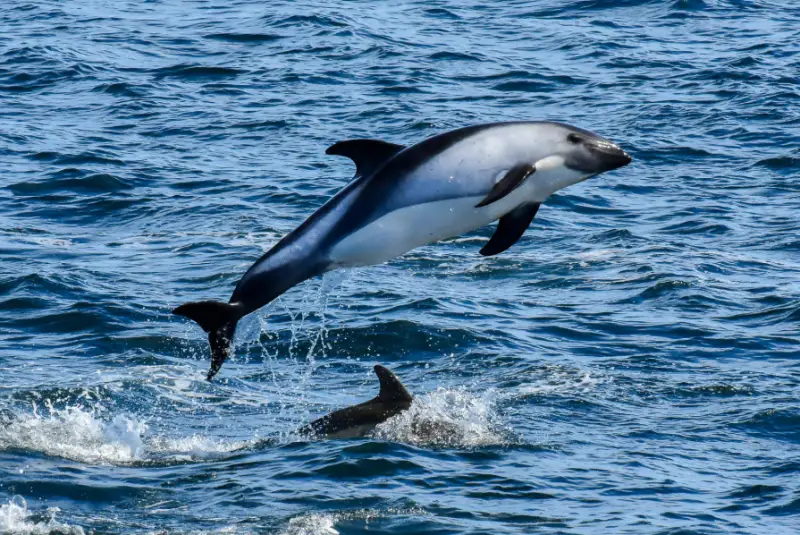
Peale’s Dolphin, found in the coastal waters near Tierra del Fuego in southern South America, is characterized by its dark gray face, chin, and predominantly black back with an off-white stripe. These dolphins measure about 6.9 feet in length and weigh approximately 253 pounds.
Known for their social behavior, Peale’s Dolphins often form small, close-knit groups and are seen leaping and surfing near shorelines. They also employ sophisticated group feeding strategies, such as forming circles or lines around their prey. Interestingly, Peale’s Dolphins do not whistle, setting them apart from many other dolphin species. They are considered to be of “Least Concern” for conservation.
Northern Right Whale Dolphin
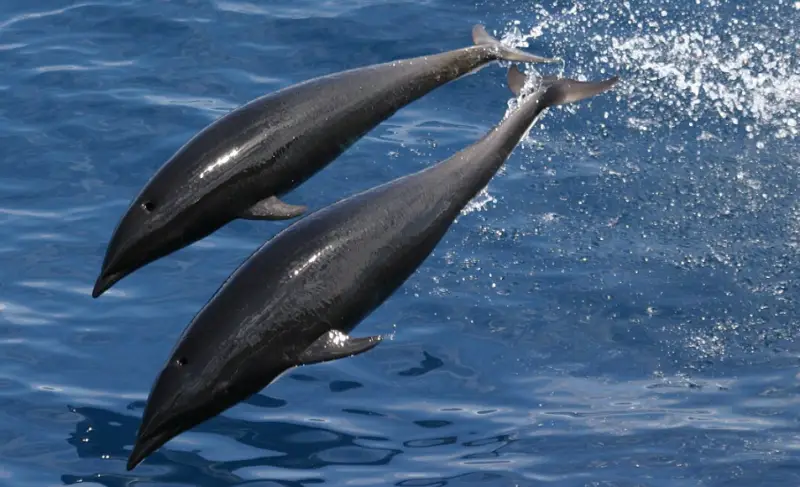
The Northern Right Whale Dolphin is a sleek and unique species found in the northern Pacific Ocean, ranging from California and Alaska to Japan. These dolphins measure between 6.6 and 9.8 feet in length and weigh between 132 and 253 pounds. Notably, they lack a dorsal fin, which distinguishes them from many other dolphin species. They also have a short, well-defined beak and small, pointed flippers and tail flukes.
Northern Right Whale Dolphins are known for forming mixed-species groups, often swimming alongside other dolphin species. Their social behaviors are unusual for marine mammals. This species is classified as “Least Concern” due to its relatively stable population.
Southern Right Whale Dolphin
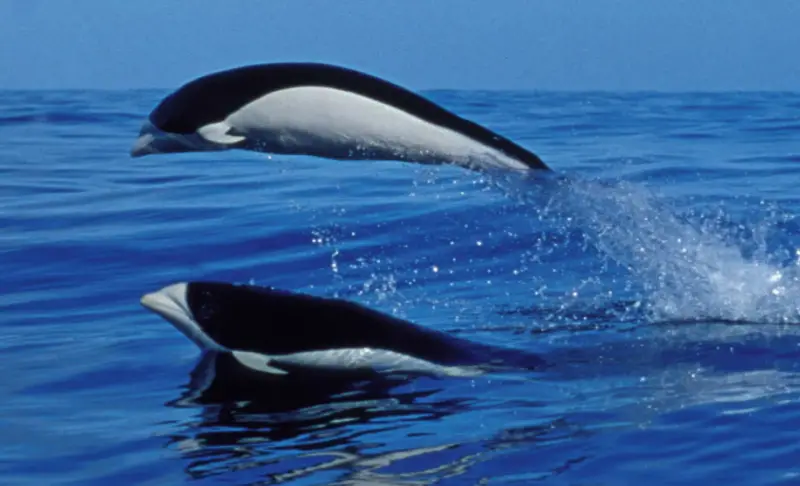
The Southern Right Whale Dolphin is found near the Sub-Antarctic Polar Front and around the Chatham and Falkland Islands. These dolphins are small and slender, with a length between 6.5 and 9.8 feet and a weight of 130 to 200 pounds. They share the same lack of a dorsal fin as their northern counterpart, giving them a sleek and streamlined appearance.
One of the most interesting aspects of the Southern Right Whale Dolphin is its skin color variations. Some individuals are entirely white or black, which is rare among dolphins. They are known for being playful and are often seen near boats. In 1998, a special hybrid dolphin was spotted, showcasing the possibility of a naturally occurring mix between the Southern Right Whale Dolphin and a Dusky Dolphin. Their conservation status is “Least Concern.”
Hourglass Dolphin
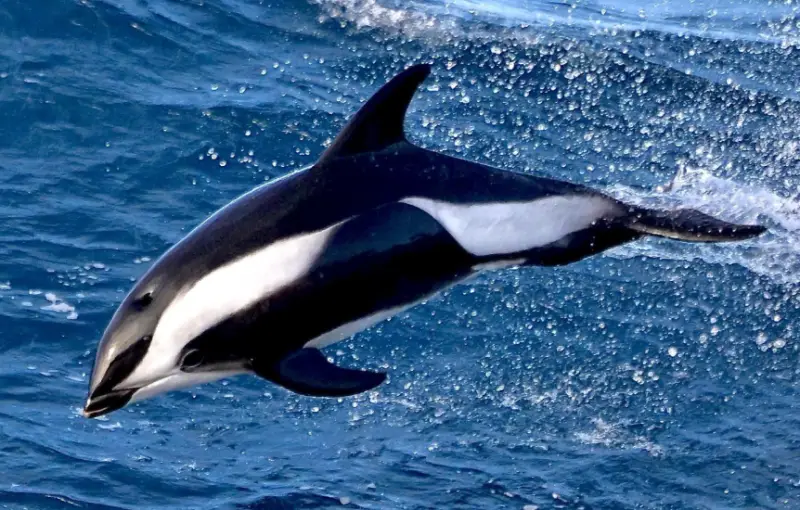
The Hourglass Dolphin is known for the distinctive hourglass pattern on its sides, which inspired its scientific name, Lagenorhynchus cruciger. These dolphins are small, measuring 5.25 to 5.9 feet in length and weighing between 198 and 265 pounds. They live in the cold waters of the Antarctic and sub-Antarctic regions, and their diet mainly consists of small fish, squid, and crustaceans.
The Hourglass Dolphin is one of the few small dolphins found in the extremely cold waters south of the Antarctic Convergence. They can live up to 46 years and are often seen leaping and swimming in front of ships and whales. Despite the harsh environment, they thrive and remain classified as “Least Concern” for conservation.
Tucuxi

The Tucuxi is a small dolphin species that inhabits the rivers of the Amazon Basin. They are known for their soft blue and gray coloration, with lighter shades of ivory, gray, or pink on their bellies. The Tucuxi has a low, triangular dorsal fin and is genetically more closely related to marine dolphins than to other river dolphins.
Tucuxis are an interesting evolutionary puzzle, as they only began entering freshwater rivers in South America a few hundred thousand years ago. This is relatively recent compared to other river dolphin species, which have been in these waters for much longer. This unique adaptation is part of their evolutionary history. They are classified as “Endangered.”
Guiana Dolphin

The Guiana Dolphin, found along the Atlantic coast of South and Central America, is known for its light bluish-grey back and pale grey belly. They have a slightly hooked, triangular dorsal fin and a moderate-length beak. Females can grow up to 7.2 feet, while males reach about 6.2 feet and weigh up to 267 pounds.
Guiana Dolphins are notable for their use of “signature whistles,” similar to human names, to communicate with one another. This was discovered in a 2014 study where researchers recorded over 800 whistles. These dolphins use the sounds to identify and communicate with individuals, showing their complex social structures. They are currently classified as “Near Threatened.”






